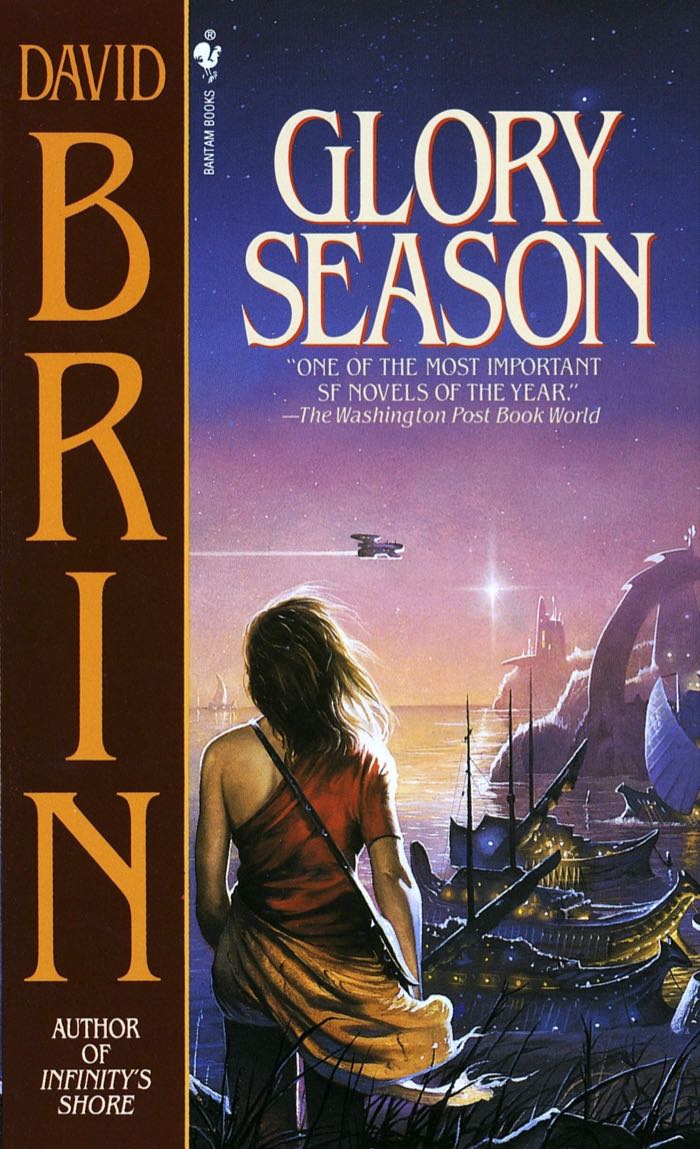Glory Season
Reviewed date: 2004 Jul 22
Rating: 3
772 pages
In David Brin's Glory Season, Maia is a regular daughter on a world where clone daughters are dominant. As a non-clone, Maia is a second-class citizen with no place in her clan, so she sets out to find her own way, to earn her fortune and perhaps save enough money to have a clone daughter and start her own clan. Maia has an advantage, though: her twin sister Leie. As identical twins they might be able to pass themselves off as clones!
David Brin is long-winded. Glory Season is strongly plot-driven, but it is also filled with introspection and character exploration. I cannot comment much on either the character development or the plot, because they are both so intertwined, and to say anything would be to spoil the book for you. I will say that Mr. Brin is a master at writing interesting plots: the action continually surprised me--and yet, after each major plot development I realized all the clues were there. Some authors pull major plot points out of thin air; Mr. Brin weaves the clues into the book in plain view, but so skillfully that their significance does not become immediately apparent.
I can say no more without giving away major plot points, so now I will discuss book binding methods. Books come in three shapes and sizes:
- Hardback
- Mass market paperback
- Trade paperback
Hardbacks are built to last, and hold up well to repeated readings. They are also expensive. I reread books rarely, so I find the advantages of hardbacks not worth the cost. Also, the dust jackets of hardbacks annoy me. Especially for heavier hardbacks, the dust jacket slips off the book when you pick it up. Collectors and purists will be aghast, but I remove the dust jacket before beginning a hardback book, and replace it only when I have finished reading the entire book.
We all are familiar with mass market paperbacks. These 4.25 x 6.75 inches books are everywhere. Mass market paperbacks are above all affordable, costing about US$6-10. They wear out quickly and do not stand up to repeated readings well, but their cost and convenient size and weight makes them the most popular form of book. The biggest source of irritation with mass market paperbacks is that when the book is thick enough, it is nearly impossible to keep it open. The cheap binding of a 500 page paperback book acts as a spring that keeps the book shut. A mass market paperback will never lie flat when opened up. To open it wide enough so you can read the entire page, you have to beat the binding into submission with a hammer. Thereby "breaking" the book. This is why mass market paperbacks wear out. Each time someone reads it, the binding is stretched and damaged, until it gives up the ghost and the book falls apart.
This brings us to the third category, trade paperbacks. These are high-quality paperbacks, but larger than mass market paperbacks, typically in the ballpark of 5.25 x 8.25 inches. Often they are the same size (or nearly the same size) as the hardbacks, are soft bound with a high quality spine, and have cover art rivaling that of hardbacks. The larger page size and higher quality binding helps prevent the "springing shut" effect that plagues mass market paperbacks. When opened up they will lie flat. Trade paperbacks typically cost from US$12-20.
My copy of Glory Season, by David Brin, is a 772 page mass market paperback. It's hard to read. I might rate it slightly higher if David Brin himself came and gave me a trade paperback version of his novel, but as it is, Glory Season is just too long. My high school English teacher used to say "It needs to be as long as it needs to be." Well, Glory Season needed to be about 400 pages, and David Brin wrote a great novel but it got lost in all the extra words he added. I rate Glory Season a three out of five.
